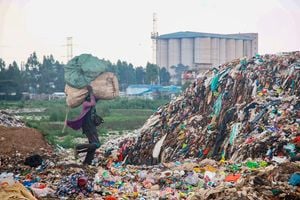
Trucks loaded with machine-cut quarry stones from Ngelani Phase Five in Mavoko, Machakos County.
Loans extended by commercial banks to companies and individuals working in the mining and quarrying sector more than doubled to Sh48 billion in the year to July, following lifting of the four-year freeze on mining permits.
This was a 106.7 per cent growth from the Sh23.2 billion the industry borrowed in a similar period last year, and a 45 per cent rise from the Sh33 billion in April, when the State lifted the freeze on issuance of new mining permits, data from the Central Bank of Kenya (CBK) shows.
The move allowed at least 400 new companies to venture into different activities within the mining industry, including mineral prospecting, mining, and marketing or exporting of ores and related products.
Players reckon the freeze lift could have increased confidence in the industry, driving up credit extended to them by commercial banks and other lenders.
“The lifting of the new permits injected some confidence in the mining and quarrying subsectors, and that did impact the credit going into the sector,” said Patrick Kanyoro, the Kenya Chamber of Mines chairperson.
In addition to the trickle-down impact of the permit freeze lift, Mr Kanyoro argues that the rise in credit demand and uptake stems from the growth in construction in the country.
“One of the likely reasons for the growth in credit for the sector is the growing construction, especially for the affordable housing as well as the general development of infrastructure across counties,” he told Business Daily.
“There is renewed confidence for support for development minerals like limestone, pozzolana, aggregates, among others, and linkages for activities such as transport and warehousing.”
Following the lifting of the moratorium, the sector is regaining momentum, triggering demand for credit.
“Since the sector is slowly picking up, there is a need for increased asset finance for trucks, backhoes, excavators, among others,” Kanyoro said.
The mining and quarrying industry is currently one of the smallest contributors to the country’s gross domestic product (GDP), having yielded Sh106 billion last year, a decline of 6.5 per cent compared to 2022 and about 0.6 per cent of the total GDP.
In quarter to June, the sector generated Sh26.9 billion, a 21 per cent growth from the Sh22.1 billion it made in the first quarter of the year, but a 2.7 per cent decline compared to last year, latest figures from the Kenya National Bureau of Statistics show.





